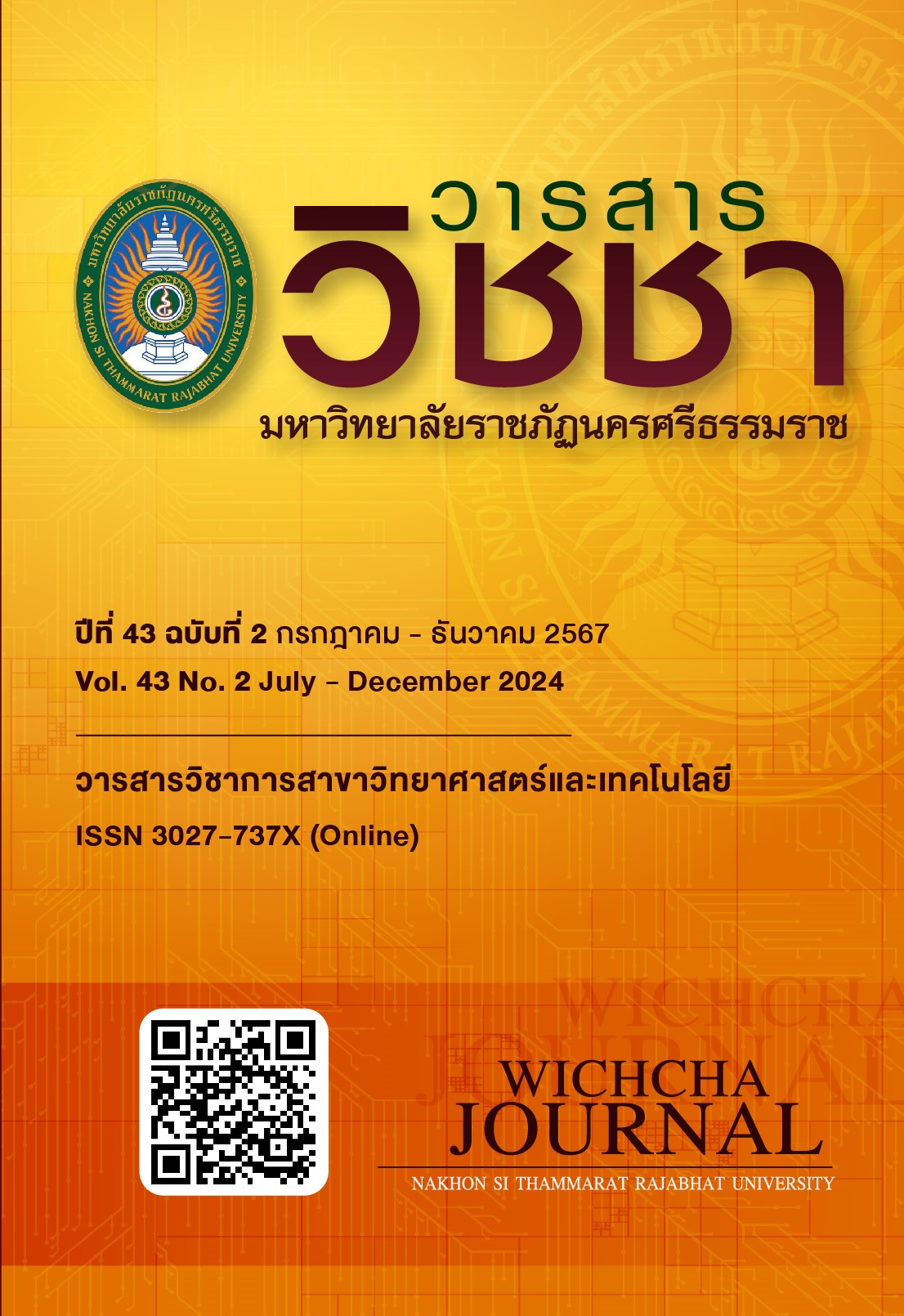การเปรียบเทียบวิธีการย่อยต่อประสิทธิภาพการวิเคราะห์ปริมาณโลหะหนักที่ปนเปื้อนในดินและผัก: กรณีศึกษาตำบลน้ำสวย อำเภอเมืองเลย จังหวัดเลย
Main Article Content
บทคัดย่อ
งานวิจัยนี้มีวัตถุประสงค์เพื่อวิเคราะห์ปริมาณโลหะหนักในดินและผักกาดเขียวกวางตุ้งด้วยวิธีการย่อย 6 วิธี คือ วิธีที่ 1 การย่อยด้วยกรดไนตริก วิธีที่ 2 การย่อยด้วยกรดไนตริกค้างคืน วิธีที่ 3 การย่อยด้วยกรดไนตริกร่วมกับไฮโดรเจนเปอร์ออกไซด์ วิธีที่ 4 การย่อยด้วยกรดไนตริกร่วมกับกรดเปอร์คลอริก วิธีที่ 5 การย่อยด้วยกรดซัลฟิวริก และวิธีที่ 6 การย่อยด้วยการเผาให้เป็นเถ้า โดยวิเคราะห์ปริมาณโลหะหนัก 3 ชนิด คือ ตะกั่ว แคดเมียม และสารหนู ด้วยเทคนิค graphite furnace-atomic absorption spectrophotometry (GF-AAS) ผลการวิจัยพบปริมาณแคดเมียม ตะกั่ว และสารหนูในผักกาดเขียวกวางตุ้งที่ความเข้มข้น ND-0.03±0.02 0.07±0.02-0.12±0.04 และ ND-0.02±0.03 มิลลิกรัมต่อกิโลกรัม ตามลำดับ และพบในตัวอย่างดินที่ความเข้มข้น ND-0.15±0.03 18.75±0.36-20.21±0.15 ND-2.04±0.03 มิลลิกรัมต่อกิโลกรัม ตามลำดับ ผลการประเมินวิธีการย่อยตัวอย่างผักกาดเขียวกวางตุ้ง 6 วิธี ต่อประสิทธิภาพการวิเคราะห์ปริมาณโลหะหนักทั้ง 3 ชนิด พบว่ามีค่าสัมประสิทธิ์สหสัมพันธ์ (r2) ≥ 0.995 และพบว่าการย่อยผักกาดเขียวกวางตุ้งด้วยวิธีที่ 6 การย่อยด้วยการเผาให้เป็นเถ้า ให้ผลดีที่สุด ความแม่นของวิธีให้ค่าร้อยละการคืนย้อนกลับ (%recovery) อยู่ในช่วงร้อยละ 99.77-90.17 ปริมาณต่ำสุดที่สามารถตรวจวัดได้ (LOD) และปริมาณต่ำสุดที่วิเคราะห์ได้ (LOQ) คือ 0.0027-0.0519 และ 0.0090-0.0519 รองลงมา คือ วิธีที่ 2 การย่อยด้วยกรดไนตริกค้างคืน และพบว่าวิธีที่ 1 การย่อยด้วยกรดไนตริก และวิธีที่ 3 การย่อยด้วยกรดไนตริกร่วมกับไฮโดรเจนเปอร์ออกไซด์ เป็นวิธีที่ยอมรับได้ ค่าใช้จ่ายไม่สูง ง่ายและมีความรวดเร็วในการวิเคราะห์มีค่าร้อยละการคืนย้อนกลับอยู่ในช่วง 85.75-80.12 และปริมาณต่ำสุดที่สามารถตรวจวัดได้ คือ 0.0497-0.0029 ปริมาณต่ำสุดที่วิเคราะห์ได้ คือ 0.1656-0.0097 การถ่ายโอนโลหะหนักจากดินสู่ผักกาดเขียวกวางตุ้งพบว่ามีปริมาณลดลงและการปนเปื้อนโลหะหนักมีค่าน้อยกว่าค่ามาตรฐานขององค์การอนามัยโลกที่กำหนดไว้ซึ่งแสดงถึงความปลอดภัยต่อการบริโภค
Article Details

อนุญาตภายใต้เงื่อนไข Creative Commons Attribution-NonCommercial-NoDerivatives 4.0 International License.
เนื้อหาและข้อมูลในบทความที่ลงตีพิมพ์ในวารสารวิชชา มหาวิทยาลัยราชภัฏนครศรีธรรมราช ถือเป็นข้อคิดเห็นและความรับผิดชอบของผู้เขียนบทความโดยตรง ซึ่งกองบรรณาธิการวารสารไม่จำเป็นต้องเห็นด้วยหรือร่วมรับผิดชอบใด ๆ
บทความ ข้อมูล เนื้อหา รูปภาพ ฯลฯ ที่ได้รับการตีพิมพ์ในวารสารวิชชา มหาวิทยาลัยราชภัฏนครศรีธรรมราช ถือเป็นลิขสิทธ์ของวารสารวิชชา มหาวิทยาลัยราชภัฏนครศรีธรรมราช หากบุคคลหรือหน่วยงานใดต้องการนำข้อมูลทั้งหมดหรือส่วนหนึ่งส่วนใดไปเผยแพร่ต่อหรือเพื่อการกระทำการใด ๆ จะต้องได้รับอนุญาตเป็นลายลักษณ์อักษรจากวารสารวิชชา มหาวิทยาลัยราชภัฏนครศรีธรรมราชก่อนเท่านั้น
The content and information in the article published in Wichcha journal Nakhon Si Thammarat Rajabhat University, It is the opinion and responsibility of the author of the article. The editorial journals do not need to agree. Or share any responsibility.
เอกสารอ้างอิง
กรมควบคุมมลพิษ. (2564). ประกาศคณะกรรมการสิ่งแวดล้อมแห่งชาติ พ.ศ. 2564 เรื่อง กำหนดมาตรฐานคุณภาพดิน. สืบค้นเมื่อ 19 เมษายน 2567, จาก: https://www.pcd.go.th/laws/25162/.
กระทรวงสาธารณสุข. (2563). ประกาศกระทรวงสาธารณสุข (ฉบับที่ 414) พ.ศ. 2563 ออกตามความในพระราชบัญญัติอาหาร พ.ศ. 2522 เรื่อง มาตรฐานอาหารที่มีสารปนเปื้อน. สืบค้นเมื่อ 19 เมษายน 2567, จาก: https://www.ratchakitcha.soc.go.th/DATA/PDF/2563/E/118/T_0017.PDF.
ทิพวรรณ นิ่งน้อย. (2549). แนวปฏิบัติการทดสอบความถูกต้องของวิธีวิเคราะห์ทางเคมีโดยห้องปฏิบัติการเดียว. รายงานวิจัย. กรมวิทยาศาสตร์การแพทย์.
เทศบาลตำบลน้ำสวย. (2561). แผนพัฒนาท้องถิ่น พ.ศ. 2561-2565. สืบค้นเมื่อ 19 เมษายน 2567, จาก: https://www.kluaykwang.go.th/index/add_file/Ztx2SpiMon21132.pdf.
นุชจรี ท้ายสนิท และปิยะดา วชิระวงศกร. (2564). การประเมินการปนเปื้อนโลหะหนักบางชนิดในดินนาข้าวของจังหวัดสุโขทัย. PSRU Journal of Science and Technology, 6(1), 99-108.
พรรณิภา แต้มดี และปิยะดา วชิระวงศกร. (2564). การปนเปื้อนโลหะหนักในดินของพื้นที่ผลิตผักเศรษฐกิจในจังหวัดพิษณุโลก. PSRU Journal of Science and Technology, 6(2), 98-108.
พุทธธิดา ด้วงกลัด และมาริสา อินทวงศ์. (2567). การวิเคราะห์ปริมาณโลหะหนักในผลิตภัณฑ์อาหารทะเลตากแห้ง โดยเทคนิคอินดักทีฟลีคัปเปิลพลาสมาออพติคอลอิมิสชันสเปกโทรเมตรี. วารสารวิชชา มหาวิทยาลัยราชภัฏนครศรีธรรมราช, 43(1), 108-121.
สมสุข ไตรศุภกิตติ มนชวัน วังกุลางกูร และวัชรา เสนาจักร์. (2558). การวิเคราะห์หาปริมาณโลหะหนักบางชนิดในผักโดยวิธีอะตอมมิกแอบซอฟชันสเปคโตรโฟโตรเมตรีในเขตพื้นที่จังหวัดมหาสารคาม. วารสารสังคมศาสตร์เพื่อการพัฒนาท้องถิ่น มหาวิทยาลัยราชภัฏมหาสารคาม, 2(4), 127-133.
AOAC International. (2002). AOAC guidelines for single laboratory validation of chemical methods for dietary supplements and botanicals. Retrieved 19 April 2024, from: https://s27415.pcdn.co/wp-content/uploads/2020/01/64ER20-7/Validation_Methods/dAOAC_Guidelines_For_Single_Laboratory_Validation_Dietary_Supplements_and_Botanicals.pdf.
Hseu, Z.Y. (2004). Evaluating heavy metal contents in nine composts using four digestion methods. Bioresource Technology, 95(1), 53-59, doi: https://doi.org/10.1016/j.biortech.2004.02.008.
Kachenko, A.G. and Singh, B. (2006). Heavy metals contamination in vegetables grown in urban and metal smelter contaminated sites in Australia. Water, Air, and Soil Pollution, 169(1), 101-123, doi: https://doi.org/10.1007/s11270-006-2027-1.
Laing, G.D., Tack, F.M.G. and Verloo, M.G. (2003). Performance of selected destruction methods for the determination of heavy metals in reed plants (Phragmites australis). Analytica Chimica Acta, 497(1-2), 191-198, doi: https://doi.org/10.1016/j.aca.2003.08.044.
Mwegoha, W. and Kihampa, C. (2010). Heavy metal contamination in agricultural soils and water in Dar es Salaam city, Tanzania. African Journal of Environmental Science and Technology, 4(11), 763-769, doi: https://doi.org/10.11648/j.ijema.20150306.13.
Rashid, H., Fardous, Z., Chowdhury, A.Z., Alam, K., Bari, L., Moniruzzaman, M., and Gan, S.H. (2016). Determination of heavy metals in the soils of tea plantations and in fresh and processed tea leaves: An evaluation of six digestion methods. Chemistry Central Journal, 10(7), doi: https://doi.org/10.1186/s13065-016-0154-3.


